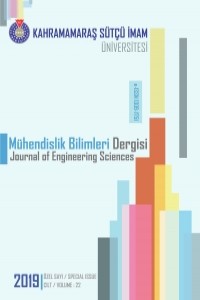INVESTIGATION OF LASER METAL DEPOSITION METHOD BY FINITE ELEMENT ANALYSIS: LASER SPEED EFFECT ON THIN WALLED GEOMETRY BUILDING
Abstract
Laser metal deposition method has emerged as one of
the additive manufacturing methods. Particularly in industry, the product
sensitivity and cost problems in the final product output have played an
important role in the development and emphasis of this method. However, there are
disadvantages arising from the parameters applied in the method of laser metal deposition.
One of these disadvantages is residual stress. The residual stress is the
effect of the tension-compression forces within the material due to heating and
cooling speeds during the production. In this study, effects of the process
parameters used in laser metal deposition method on the elimination of the
residual stress problem and the quality of the product to be obtained were
analyzed by the finite element method and the thermal results were compared. Simufact
program was used for this study. After being transferred into a 3D design
module, changes are made on the values other than the standard parameters and
the analyzes are made and the effects on the residual stress are determined. In
this method, Simufact program allows analysis of laser speed, layer thickness
and temperature parameters. For the analysis of this study, the laser velocity
was chosen from the method parameters and the results of the analysis were performed
to investigate the effect of the laser velocity.
References
- Agarwala M, Bourell D, Beaman J, Marcus H, Barlow J, (1995) “Direct selective laser sintering of metals”, Rapid Prototyping Journal, V1, N1,pp 26-36
- Dobson, S., Wu, Y., Yang, L. (2018) Material characterization for light weight thin wall structures using laser powder bed fusion additive manufacturing. Proceedings of the 29th Annual International Solid Freeform Fabrication Symposium – An Additive Manufacturing Conference
- Ermurat, M. (2009). Lazerli doğrudan metal parça imalatı sisteminin geliştirilmesi, üretilen parça özelliklerinin incelenmesi ve sistem optimizasyonu. Kocaeli Üniversitesi
- Fathi A, Toyserkani E, Khajepour A ve Durali M, (2006) “Prediction of melt pool depth and dilution in laser powder deposition”, J. Phys. D: Appl. Phys. 39 2613–2623
- Hitz B, Ewing J J, Hecht J, (2001) “Introduction to Laser Technology”, Institute of Electrical and Electronics Engineers Inc,104-109
- Kathuria Y.P:(1997) “Laser cladding process: a sutdy using stationary and scanning CO2 laser beams”, Surface and Coatings Technology 97, pp 442-447
- Koechner W., (2006) “Solid-State Laser Engineering”, Springer Science Business Media Inc, 3-4.
- Poyraz, Ö. (2018). Metallerin Lazer Katmanlı İmalatında Kullanılan Proses Parametrelerinin Etkisinin, Modelleme ve Simülasyon Yöntemleri Kullanılarak İncelenmesi. Eskişehir Osmangazi Üniversitesi
- Shao T. M., Lin X. C., Zhou M, (2001) “Absorption of some powder materials to YAG laser”, Science in China (A Serisi), Vol 44
- Zhan, x., Lin, X., Gao, Z., Qi, c., Zhou, J., Gu, D. (2018). Modeling and simulation of the columnar-to-equiaxed transition during laser melting deposition of Invar alloy. Journal of Alloys and Compounds 755 (2018) 123e134
LAZERLİ METAL YIĞMA YÖNTEMİNİN SONLU ELEMANLAR ANALİZİYLE İNCELENMESİ: İNCE DUVAR GEOMETRİSİ ÜRETİMİNDE İLERLEME HIZI ETKİSİ
Abstract
Lazerli metal yığma yöntemi eklemeli imalat
yöntemlerinden biri olarak ortaya çıkmıştır. Özellikle sanayide son ürün
çıktısındaki malzeme ürün hassasiyeti ve maliyet açısından yaşanan problemler
bu yöntemin geliştirilmesinde ve üzerinde önemle durulmasında önemli bir rol
üstlenmiştir. Ancak Lazerli metal yığma yönteminde yöntem gereği uygulanan
parametrelerden kaynaklı dezavantajları bulunmaktadır. Bu dezavantajlardan
birisi ise artık gerilmedir. Artık gerilme imalat sırasında ısınma ve soğuma
hızlarına bağlı olarak, malzeme içerisinde kalan basma-çekme kuvvetlerinin
etkisidir. Bu çalışmada Lazerli metal yığma yönteminde kullanılan proses
parametrelerinin artık gerilme probleminin giderilmesi ve elde edilecek ürünün
kalitesinin artırılması üzerindeki etkileri sonlu elemanlar yöntemiyle analiz
edilmiş ve termal sonuçları karşılaştırılmıştır. Çalışma için Simufact
programından yararlanılmıştır. 3 boyutlu tasarım modül içerisine aktarıldıktan
sonra standart parametreler dışındaki değerler üzerinde değişiklikler yapılarak
analizler yapılmakta ve bu analiz değerleri karşılaştırılarak artık gerilme
üzerindeki etkileri belirlenmektedir. Bu yöntemde analiz için Simufact programı
lazer hızı, katman kalınlığı ve sıcaklık parametrelerinde analizler yapılmasına
izin vermektedir. Bu çalışmadaki analizler için yöntem parametrelerinden lazer
hızı seçilmiş ve analiz sonucundaki karşılaştırmalar lazer hızının etkisini
araştırma adına yapılmıştır.
References
- Agarwala M, Bourell D, Beaman J, Marcus H, Barlow J, (1995) “Direct selective laser sintering of metals”, Rapid Prototyping Journal, V1, N1,pp 26-36
- Dobson, S., Wu, Y., Yang, L. (2018) Material characterization for light weight thin wall structures using laser powder bed fusion additive manufacturing. Proceedings of the 29th Annual International Solid Freeform Fabrication Symposium – An Additive Manufacturing Conference
- Ermurat, M. (2009). Lazerli doğrudan metal parça imalatı sisteminin geliştirilmesi, üretilen parça özelliklerinin incelenmesi ve sistem optimizasyonu. Kocaeli Üniversitesi
- Fathi A, Toyserkani E, Khajepour A ve Durali M, (2006) “Prediction of melt pool depth and dilution in laser powder deposition”, J. Phys. D: Appl. Phys. 39 2613–2623
- Hitz B, Ewing J J, Hecht J, (2001) “Introduction to Laser Technology”, Institute of Electrical and Electronics Engineers Inc,104-109
- Kathuria Y.P:(1997) “Laser cladding process: a sutdy using stationary and scanning CO2 laser beams”, Surface and Coatings Technology 97, pp 442-447
- Koechner W., (2006) “Solid-State Laser Engineering”, Springer Science Business Media Inc, 3-4.
- Poyraz, Ö. (2018). Metallerin Lazer Katmanlı İmalatında Kullanılan Proses Parametrelerinin Etkisinin, Modelleme ve Simülasyon Yöntemleri Kullanılarak İncelenmesi. Eskişehir Osmangazi Üniversitesi
- Shao T. M., Lin X. C., Zhou M, (2001) “Absorption of some powder materials to YAG laser”, Science in China (A Serisi), Vol 44
- Zhan, x., Lin, X., Gao, Z., Qi, c., Zhou, J., Gu, D. (2018). Modeling and simulation of the columnar-to-equiaxed transition during laser melting deposition of Invar alloy. Journal of Alloys and Compounds 755 (2018) 123e134
Details
| Primary Language | English |
|---|---|
| Subjects | Mechanical Engineering |
| Journal Section | Research Article |
| Authors | |
| Publication Date | November 29, 2019 |
| Submission Date | August 2, 2019 |
| Published in Issue | Year 2019 Volume: 22 - Special Issue |

